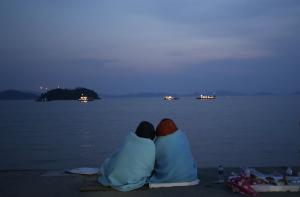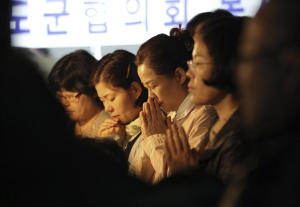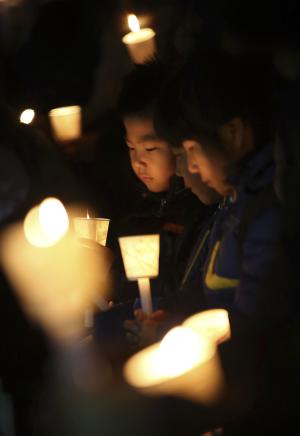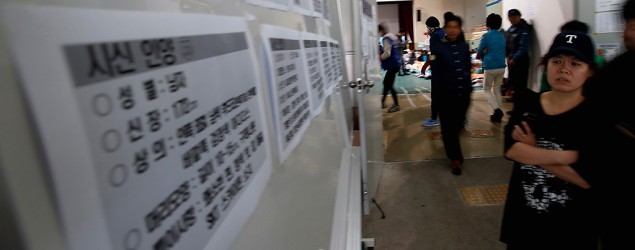Watch video
JINDO, South Korea (AP) — South Korean President Park Geun-hye said Monday that the captain and some crew members of the sunken ferry committed "unforgivable, murderous behavior," while criticism of her own government's handling of the disaster grew.
As divers continued to search the interior of the submerged vessel, the confirmed death toll rose to 86, according to information from the coast guard posted for the victims' families. About 220 people remain missing.
The captain initially told passengers to stay in their rooms and waited more than half an hour to issue an evacuation order as the ferry Sewol sank Wednesday. By then the ship had tilted so much it is believed that many passengers were trapped inside.
Park said at a Cabinet briefing, "What the captain and part of the crew did is unfathomable from the viewpoint of common sense. Unforgivable, murderous behavior." The comments were posted on the website of the presidential Blue House.
Park said instead of following a marine traffic controller's instructions to "make the passengers escape," the captain "told the passengers to stay put while they themselves became the first to escape."
"Legally and ethically," she said, "this is an unimaginable act."
View gallery

Relatives of passengers aboard the sunken ferry Sewol sit near the sea at a port in Jindo, south of …
The captain, Lee Joon-seok, and two crew members have been arrested on suspicion of negligence and abandoning people in need, and prosecutors said Monday that four other crew members have been detained. Senior prosecutor Ahn Sang-don said prosecutors would decide within 48 hours whether to seek arrest warrants for the four: two first mates, a second mate and a chief engineer.
Lee, 68, has said he waited to issue an evacuation order because the current was strong, the water was cold and passengers could have drifted away before help arrived. But maritime experts said he could have ordered passengers to the deck — where they would have had a greater chance of survival — without telling them to abandon ship.
Video showed that Lee was among the first people rescued. Some of his crew said he had been hurt, but a doctor who treated him said he had only light injuries.
Lee spoke of "pain in the left rib and in the back, but that was it," said Jang Ki-joon, director of the orthopedic department at Jindo Hankook University. Jang said he did not realize Lee was the captain until after he treated him.
Many relatives of the dead and missing also have been critical of the government, which drew more outrage Monday with the resignation of Song Young-chur, a high-ranking official in the Ministry of Security and Public Administration.
Song, chief of the Regional Development Policy Bureau, reportedly tried to take a commemorative photo Sunday evening of the situation room on Jindo, an island near the sunken ferry, where government officials brief relatives of the missing.
Yonhap news agency reported that one family member shouted, "We are a nervous wreck here, and this is something to commemorate for you?"
Blue House spokesman Min Kyung-wook said the government accepted Song's resignation "as a warning to others, as he has raised public resentment by trying to take commemorative photos without understanding the feeling of the families of the victims and lost persons."
It was the latest of several missteps. Soon after the sinking the government announced that 368 passengers had been saved; the real number is just 174. Some relatives of the missing issued a statement saying that hours after the ship sank, no one from the government was available to brief them and they were turned back when they tried to get closer to the accident site.
There also has been criticism of the government's emergency preparedness. Various ministries set up "central emergency centers" across the country without coordinating their efforts. Some leaders lacked experience in disaster relief, including the deputy head of the Central Relief Center, who formerly led the National Archives of Korea.
Government officials have complained about false reports, and on Sunday night police arrested a woman on libel charges. Hong Ga-hye, 26, was introduced as a civilian diver in a South Korean cable news interview Friday in which she said rescue aid was not arriving as promised and that a diver communicated with a survivor through a wall of the sunken ferry, claims that authorities say were false. A sobbing Hong apologized to victims' families after appearing at a police station.
About 250 of the missing and dead are students from a single high school near Seoul who were on their way to the southern tourist island of Jeju.
Divers were unable for days to enter the submerged ship because of strong currents, bad weather and low visibility. Over the weekend they were able to use a new entryway through the dining hall, resulting in a jump in the discovery of corpses.
On Jindo, relatives of the missing must search white signboards giving sparse details such as gender, height, hair length and clothing to see if their loved ones have been found.
No names are listed, just the slimmest of clues about mostly young lives now lost. Many favored hoodies and track pants. One girl painted her fingernails red and toenails black. Another had braces on her teeth.
View gallery

Relatives of missing passengers aboard the sunken ferry Sewol pray to wish for safe return of their …
"I'm afraid to even look at the white boards," said Lim Son-mi, 50, whose 16-year-old daughter, Park Hye-son, has not been found. "Because all the information is quite similar, whenever I look at it, my heart breaks."
Relatives have already lined up to give DNA samples at the gymnasium where many are staying, to make bodies easier to identify when they are recovered.
A transcript released by the coast guard Sunday shows the ship, which carried 476 people, was crippled by confusion and indecision well after it began listing Wednesday.
About 30 minutes after the Sewol began tilting, a crew member repeatedly asked a marine traffic controller whether passengers would be rescued if they abandoned the ship off South Korea's southern coast.
That followed several statements from the ship that people aboard could not move and another in which someone said it was "impossible to broadcast" instructions.
View gallery

Kindergartens hold candles as they pray for safe return of passengers of the sunken ferry Sewol, in …
The cause of the disaster is not yet known, but prosecutors have said the ship made a sharp turn before it began to list.
The Sewol's captain was arrested Saturday, along with one of the ship's three helmsmen and a 25-year-old third mate. The third mate was steering at the time of the accident, in a challenging area where she had not steered before, and the captain said he was not on the bridge at the time.
Authorities have not identified the third mate, though a colleague identified her as Park Han-kyul. Senior prosecutor Ahn said Monday that the third mate has told investigators why she made the sharp turn, but he would not reveal her answer, and more investigation is needed to determine whether the answer is accurate.
___
Kim reported from Mokpo, South Korea. Associated Press writers Foster Klug, Youkyung Lee, Jung-yoon Choi and Leon Drouin-Keith in Seoul and Minjeong Hong in Jindo contributed to this report.
View Gallery
President: Actions of crew tantamount to murder

South Korean leader Park Geun-hye says the conduct of the crew on the ill-fated ferry was unfathomable.
Possible homicide charges